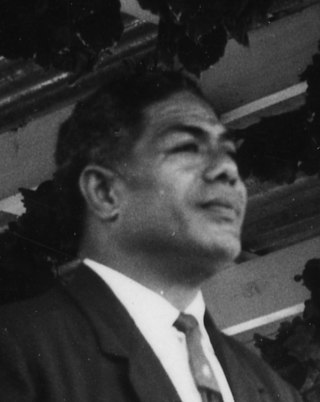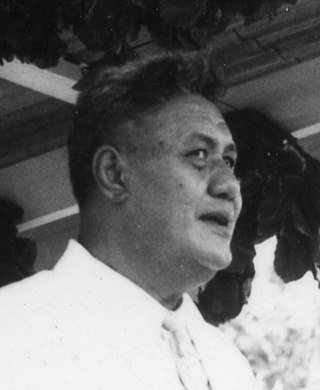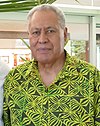
Politics of Samoa takes place in a framework of a parliamentary representative democratic state whereby the Prime Minister of Samoa is the head of government. Existing alongside the country's Western-styled political system is the fa'amatai chiefly system of socio-political governance and organisation, central to understanding Samoa's political system.

Malietoa Tanumafili II, addressed Susuga Malietoa Tanumafili II, was the Malietoa, the title of one of Samoa's four paramount chiefs, and the head of state, or O le Ao o le Malo, a position that he held for life, of Samoa from 1962 to 2007. He was co-head of state in 1962 with the tama-a-'aiga Tupua Tamasese Mea'ole and became the sole head of state on 15 April 1963 upon the death of his co-regent. At the time of his death, he was the oldest national leader in the world, and was also the last incumbent president for life in the world. He was also the first head of state to be a follower of the Bahá’í Faith.

Tupua Tamasese Mea'ole was a Western Samoan paramount chief. He held the royal title of Tupua Tamasese from 1929 to 1963, and O le Ao o le Malo jointly with Malietoa Tanumafili II from 1962 until his death the following year.

Samoa is made up of eleven itūmālō. These are the traditional eleven districts that were established well before European arrival. Each district has its own constitutional foundation (faavae) based on the traditional order of title precedence found in each district's faalupega.

Ātua is an ancient political district of Samoa, consisting of most of the eastern section of Upolu and the island Tutuila. Within Samoa's traditional polity, Ātua is ruled by the Tui Ātua together with the group of six senior orators of Lufilufi and 13 senior matai from throughout Ātua, comprising the Fale Ātua. The fono (meeting) of Atua's rulers takes place in Lufilufi on the great malae of Lalogafu'afu'a.

Tui Ātua Tupua Tamasese Tupuola Tufuga Efi is a Samoan political leader and as holder of the maximal lineage Tama-a-'āiga title of Tupua Tamasese, is one of the four paramount chiefs of Samoa. He also holds the royal pāpā title of Tui Atua.

Tupua (known as Tupua Tamasese) is a state dynasty and one of the four paramount chiefly titles of Samoa, known as the Tama-a-Aiga or 'Sons of the Great Families'). It is the titular head of one of Samoa's two great royal families - Sā Tupua, the lineage of Queen Salamasina. The 'Tupua' refers to Salamasina's descendant, King Tupua Fuiavailili, who was the first to unite both of Salamasina's descent lines in his personage and ascended to the Kingship of Samoa in c.1550, upon the death of his adoptive father, King Muagututi'a. Tupua Fuiavailili was adopted by his aunt, Fenunu'ivao (daughter of Leutele and wife of King Muagututi'a) and named as the King's successor. Tupua's rise also led to the first usage of the term "Tama-a-'aiga" by the orator polity of Leulumoega and Lufilufi, in reference to his many genealogical connections to the great families of Ātua. The 'Tamasese' part refers to his descendant Tupua Tamasese Titimaea, whose prowess in battle and generosity won favour with many of his followers and whose actions restored the Salamasina line's prestige. All subsequent Tupua title holders have thus carried the two names together since then.

Susuga Malietoa Tanumafili I was the Malietoa in Samoa from 1898 until his death in 1939. After the death of his father, Malietoa Laupepa, the recognized King of Samoa by many western countries, Tanumafili was immediately crowned as King, alongside Tupua Tamasese Lealofi I as vice-king. Tanumafili was backed by the United States and United Kingdom, however Germany supported rebel chief Mata'afa Iosefo who eyeing the throne. The battle between the two made up the Second Samoan Civil War and in the end caused the Tripartite Convention that split the islands. After the war, Malietoa pursued education in Fiji and then came back to Samoa, where he was appointed as an advisor.

Falefā is located on the north eastern coast of Upolu island in Samoa. It was the ancient capital during the ‘Malo’ (‘government’) of Tupu Tafa'ifa (King) Fonoti. After having defeated his siblings Va'afusuaga and Samalaulu for control of Samoa, King Fonoti chose to rule from his new seat in Falefa, an honour remembered in its faalupega to this day.

General elections were held in Samoa on 2 March 2001 to determine the composition of the 13th Parliament. Prime minister Tuilaʻepa Saʻilele Malielegaoi led the Human Rights Protection Party (HRPP) into the election. Opposition leader and former prime minister and future head of state, Tui Ātua Tupua Tamasese Efi led the Samoan National Development Party (SNDP) into the election. The HRPP won 23 seats, but initially fell short of a majority. The SNDP won 13 seats, the Samoan United People's Party secured one seat and the remaining 12 were won by independents. Following the election, all 12 independents joined the HRPP, giving the party a majority in parliament and allowing Tuila'epa to remain prime minister.

An indirect election was held in Apia to elect the O le Ao o le Malo of Samoa on 16 June 2007 after the death of the country's head of state for four and a half decades, Malietoa Tanumafili II, in May 2007. Former Prime Minister Tui Ātua Tupua Tamasese Efi was elected unopposed by the 49-member strong parliament. This O le Ao o le Malo election was the first to occur since Samoa gained independence in 1962.

Fa'amatai is the indigenous political ('chiefly') system of Samoa, central to the organization of Samoan society. It is the traditional indigenous form of governance in both Samoas, comprising American Samoa and the Independent State of Samoa. The term comprises the prefix fa'a and the word matai.
The Samoan Order of Merit is an order recognizing distinguished service in science, art, literature, or religion. Per the Honours and Awards Act 1999, admission into the organization is granted by the O le Ao o le Malo, presently Vaʻaletoʻa Sualauvi II, and is limited to 15 living individuals from Samoa, plus an unspecified number of foreigners. All members receive the ability to use the post-nominal letters OM and a medallion to wear, and in the Samoan order of precedence fall between Companions and Officers of the Order of Samoa.

General elections were held in Western Samoa on 21 February 1976. All candidates ran as independents and voting was restricted to Matai and citizens of European origin, with the Matai electing 45 MPs and Europeans two. Following the election, Tupuola Efi became Prime Minister.

Indirect elections for the o le Ao o le Malo were held in Apia on 19 July 2012. Incumbent Tui Ātua Tupua Tamasese Efi was the only candidate, and was re-elected unopposed. He had been nominated by Prime Minister Tuila'epa Sa'ilele Malielegaoi and seconded by Palusalue Fa’apo II, the leader of the opposition.

Tuimaleali'ifano is one of the four paramount chiefly titles of Samoa, known as the Tama-a-Aiga. Samoa's other three paramount chiefs are Malietoa, Mata'afa and Tupua Tamasese. The seat of the Tuimaleali'ifano title is at Falelatai in the Aʻana district.

Tui Ātua Tupua Tamasese Lealofi IV was the second prime minister of Samoa from 25 February 1970 to 20 March 1973 and again from 21 May 1975 to 24 March 1976. He held the title of Tupua Tamasese, one of the four main chiefly titles of Samoa from 1965 until his death in 1983.

AfiogaTuimalealiʻifano Vaʻaletoʻa Eti Sualauvi II is a Samoan politician who is the current O le Ao o le Malo of Samoa, in office since 2017.

The Council of Deputies is a constitutional body in Samoa. Its members serve as Deputy O le Ao o le Malo and act as head of state when the O le Ao o le Malo is unable to fulfill their duties due to absence or incapacitation.
The 2023 Samoa Honours and Awards were appointments made by the O le Ao o le Malo of Samoa, Tuimalealiʻifano Vaʻaletoʻa Sualauvi II, to various Orders, decorations, and medals of Samoa under the Honours and Awards Act 1999. The awards were announced on 31 May 2023. This was the first awards ceremony held since the 2017 Samoa Honours and Awards.





















